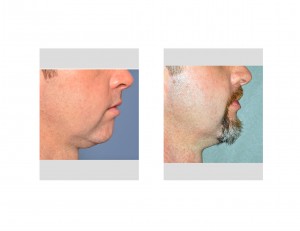The wearing of facial hair at one time in history represented a matter of convenience, the man didn’t want to bother with the nuisance of shaving. Men wearing facial hair today, however, is done much more often for style reasons and to create a specific facial look. This is evidenced by the observation that many facial hair styles require daily work to keep them in good shape. This is most evident in the manicuring required of a goatee.

But for those men who want to lose the facial hair and the daily grooming, chin augmentation can save one hundreds of hours over years. One of the more simpler and less complicated of all the facial implant procedures, it requires just one hour or less of surgery to get the chin you always wanted. Through a small incision of just one inch or inch and a half under the chin (the incision is often less than 25% of the total chin implant length), an implant can be slide in and along both sides of the jawline and centered over the midportion of the weaker chin bone. The subsequent scar under the chin heals in an inconspicous manner.

To improve the shape and strength of the male chin, external facial hair or an internal implant can be used. Each approach has its own advantages but the chin implant eliminates the need for any daily care and maintenance.
Dr. Barry Eppley
Indianapolis, Indiana


